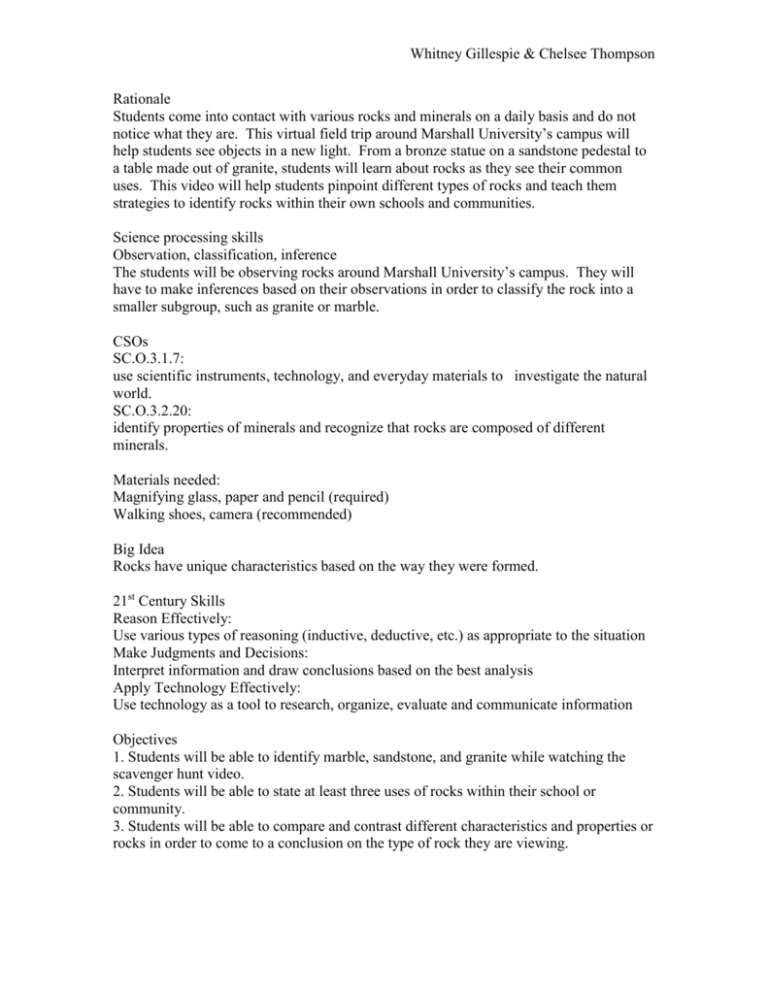BrochureInfo - ci350ci448project
advertisement

Whitney Gillespie & Chelsee Thompson Rationale Students come into contact with various rocks and minerals on a daily basis and do not notice what they are. This virtual field trip around Marshall University’s campus will help students see objects in a new light. From a bronze statue on a sandstone pedestal to a table made out of granite, students will learn about rocks as they see their common uses. This video will help students pinpoint different types of rocks and teach them strategies to identify rocks within their own schools and communities. Science processing skills Observation, classification, inference The students will be observing rocks around Marshall University’s campus. They will have to make inferences based on their observations in order to classify the rock into a smaller subgroup, such as granite or marble. CSOs SC.O.3.1.7: use scientific instruments, technology, and everyday materials to investigate the natural world. SC.O.3.2.20: identify properties of minerals and recognize that rocks are composed of different minerals. Materials needed: Magnifying glass, paper and pencil (required) Walking shoes, camera (recommended) Big Idea Rocks have unique characteristics based on the way they were formed. 21st Century Skills Reason Effectively: Use various types of reasoning (inductive, deductive, etc.) as appropriate to the situation Make Judgments and Decisions: Interpret information and draw conclusions based on the best analysis Apply Technology Effectively: Use technology as a tool to research, organize, evaluate and communicate information Objectives 1. Students will be able to identify marble, sandstone, and granite while watching the scavenger hunt video. 2. Students will be able to state at least three uses of rocks within their school or community. 3. Students will be able to compare and contrast different characteristics and properties or rocks in order to come to a conclusion on the type of rock they are viewing. Whitney Gillespie & Chelsee Thompson Science Background Content A rock is generally composed of two or more minerals. They can be put into three different categories based on how they were formed: igneous, sedimentary, or metamorphic. Igneous rocks are formed from magma. As magma gets closer to the earth’s surface and cools, it becomes igneous rocks. Granite, gabbro, and basalt are all types of igneous rocks. Seventy percent of rocks are sedimentary. They are formed when pieces of pebble, sand, clay, and gravel are put under pressure. Most of these rocks form under water are examples include sandstone and limestone. Metamorphic rocks are formed when heat and pressure are applied. Chemical reactions can occur deep within the Earth’s surface and cause one type of rock to turn into metamorphic rock. The heat comes from the magma and the pressure comes from many other layers of rocks. Examples of metamorphic rocks include marble and slate. Some information about rocks: Limestone It is white or gray in color. It is formed from the mineral calcite and sometimes fossils (from shells). It is a sedimentary rock. Sandstone Is red or gray in color. It is formed from sand grains that have been pressurized together. It is a sedimentary rock. Granite Is pink or gray in color. It is formed when the minerals feldspar and quartz erupt from a volcano, then cool. It is an igenous rock. Marble Is mostly white, but can come in many different colors. Limestone turns into marble when it is subjected to pressure for a very long duration of time. It is a metamorphic rock.








